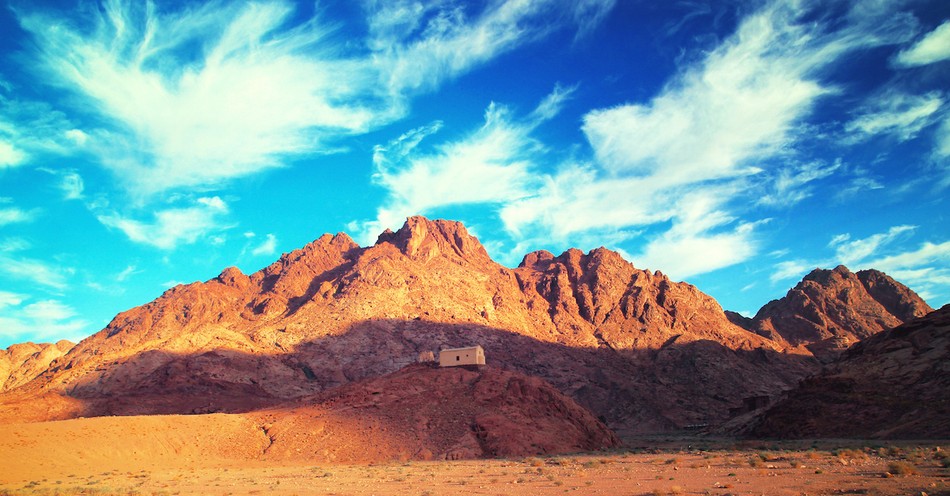Mount Sinai could be debated as one of the most iconic biblical landmarks. Many people associate the site with Moses and the 10 Commandments, but other Bible stories are set there as well. Where is Mount Sinai located? What events transpired there? Are travelers able to visit the mountain today? Let’s take a closer look at the specifics of Mount Sinai and where we find the landmark in Scripture.
Where Is Mount Sinai Located in the Bible?
Mount Sinai’s exact location is disputed among many. Early Christians identified Mount Serbal, the fifth largest mountain in Egypt, as the landmark’s location. Travel further southeast to find the highest mountain in Egypt, Mount Catherine. The historian Josephus named this spot as the landmark in the sixth century. Further north is the Sinai Peninsula where Christians named Mount Sinai’s location in the third century AD.
Others believe Mount Sinai isn’t in Egypt at all, but instead Saudi Arabia since Moses traveled that way during his exile. Another opinion places the landmark at Har Karkam in Israel. This belief is held by Emmanuel Anatim, a modern archeologist who claims biblical art resides within the 2,700-foot ridge. In conclusion, there are many speculated locations as the location of Mount Sinai.
What Happened on Mount Sinai in the Bible?
After the Israelites escaped Egypt, they came to the desert of Sinai. God spoke to Moses from the mountain telling him he would come to speak to the people in a cloud. After the Israelites made their preparations, the awaited day came. God called Moses up to the mountain but told him the people were not allowed to come up and the place should be set apart as holy.
Then God spoke and gave the 10 Commandments as well as other instructions. These commands can be found in Exodus 20-23. After God spoke, Moses descended the mountain and repeated the Lord’s commands. The Israelites promised to do as the Lord had said.
In Exodus 24:12, The LORD said to Moses, “Come up to me on the mountain and stay here, and I will give you the tablets of stone with the law and commandments I have written for their instruction.” A cloud covered the mountain for six days. On the seventh day, God spoke to Moses. He instructed him to come inside the cloud, and he remained there for 40 days and 40 nights.
God instructed Moses on how to build the Tabernacle including the Ark of the Covenant. He also gave guidelines for the priests’ garments and consecration. Exodus 31:18 states “When the LORD finished speaking to Moses on Mount Sinai, he gave him the two tablets of the covenant law, the tablets of stone inscribed by the finger of God.”
While Moses was with God, the Israelites became impatient at the foot of the mountain. They made a golden calf and began worshipping the idol. God grew angry and threatened to bring disaster to the people. Moses pleaded to have mercy on them and God relented. Moses descended the mountain and saw the Israelites worshipping the golden calf. He became angry and threw the two tablets, causing them to shatter into pieces.
Later in Exodus 34. Moses brought two more tablets to the Lord on Mount Sinai. He again stayed 40 days and f40 nights and wrote the 10 Commandments on the tablets. He returned to the Israelites with the commandments and a face radiant from speaking with the Lord.
Can You Visit Mount Sinai from the Bible Today?
As stated above, people debate the exact location of Mount Sinai. One of the locations is near the Saint Catherine Monastery on the Sinai Peninsula. While the monastery is not an organized tourist site, the grounds are open to visitors. Due to its reverent history, organized guided tours and recordings are not permitted. From the monastery, visitors can choose two different routes to The Holy Summit of Sinai which extends 2,285 meters.
Both trips take between five to seven hours. One choice is to climb the 3,750 steps known as The Steps of Repentance built in the 6th century. This is the steeper more difficult route, but also more historic. The other is the Camel Trail constructed by Abbas Pasha I in the middle of the 19th century.
This path is less direct and the assent is more gradual. Camels are also available at the bottom of the site and can travel most of the way. Visitors on this journey join with those taking The Steps of Repentance in the last 750 steps. For travelers who would like to stay overnight, there is a guest house available below the monastery. Guests have private facilities and access to meals.
3 Interesting Facts about Mount Sinai in the Bible
1. Touching the mountain was deadly. God specifically requested Moses to approach him on the mountain, but the Israelites were not to set foot on the holy ground. God declared in Exodus 19:12-13 that “Whoever touches the mountain is to be put to death.
They are to be stoned or shot with arrows.” Matthew Henry explains the reasoning behind the statement. He says “This was to intimate that humble awful reverence which ought to possess the minds of all those that worship God. We are mean creatures before a great Creator, vile sinners before a holy righteous Judge; and therefore a godly fear and shame well become us.”
When God began speaking the 10 Commandments, the Israelites backed away in fear. They told Moses to repeat the directions from God because they would die if he spoke directly to them. We should remember this took place in the Old Testament before the time of Jesus, and while a reverent fear of God is healthy, we no longer have a line in the sand between us and the Creator.
2. Moses had another encounter at the mountain. Many are familiar with the story of the burning bush, but do they know the story’s setting was Mount Horeb, also known as Mount Sinai? In Exodus 3, Moses was tending sheep when God called to him from the dancing flames. Before he could approach the bush he needed to remove his shoes since the ground was now holy.
During his appearance, God summoned Moses to free the Israelites from Egypt. He promised to be with him and help the people successfully escape. God told him to begin by asking permission to take a three-day journey to worship at Mount Sinai since this would be a more reasonable request.
Moses gave many reasons why he wasn’t a good candidate for the job and begged God to send someone else to carry out the task. But God had chosen Moses. Therefore, Moses went.
3. Moses wasn’t the only one who met God there. Years after Moses’s encounters with God at Mount Sinai, we find the prophet Elijah in a meeting with the evil King Ahab. Elijah calls out the king for turning from God and following the false idol, Baal, instead. The two men set up a challenge. They would both summon their Gods and see whose responded.
The followers of Baal put on quite a show begging him to turn up, but they heard only crickets. Nothing happened. However, when Elijah called on God fire fell from heaven. The people turned toward the One True God, but another figure at the time, Jezebel, was not happy with the turn of events.
She declared Elijah a dead man, and he ran for his life. He found a safe haven where God spoke to him as he had to Moses. Where was this majestic place? No other than Mount Sinai.
Amazing stories took place at Mount Sinai. God spoke to both Moses and Elijah at the site. He called them to a purpose and gave them important commandments. These men surely had to be in awe that God chose to appear to them.
Today, with the sacrifice of Jesus, we can approach God on our own mountains, but also in our valleys. In the Old Testament, God had to call out to his people and let them know he was there. We don’t have to go through silent waiting periods anymore. As Christians, we can call out to God, and he will meet us wherever we are, even where we find ourselves sitting at this very moment.
Further Reading
Why Is Mount Sinai One of the Most Important Landmarks in the Bible?
What Is the Significance of Mount Sinai in the Bible?
Photo credit: ©GettyImages/karamba70

Jenna Brooke Carlson is an elementary dual language teacher in the Chicago suburbs. As a member of American Christian Fiction Writers and Word Weavers, she enjoys spending time with other writers and perfecting her craft. Her debut novel, Falling Flat, spreads the message that healing can occur, even after tragedy. Along with writing, she’s pursuing her dreams of creating a community of brave young women, who she can encourage to live out their dreams amid challenges and imperfection. Her days are busy, but she’s determined she can conquer anything with a fuzzy blanket and a hot cup of tea. To find out more about Jenna, visit her website at jennabrookecarlson.com.
This article is part of our Bible resource for understanding the significance and meaning of biblical phrases and ideas. Here are our most popular Bible articles to grow in your knowledge of God's Word:
Promises of God in the Bible
Is "This Too Shall Pass" in the Bible?
What Was the Ark of the Covenant?
Top 10 Bible Stories for Kids
“Iron Sharpens Iron” in Proverbs 27:17
"Fearfully and Wonderfully Made" in Psalm 139
“Be Still and Know That I am God” in Psalm 46:10
"No Weapon Formed Against Me Shall Prosper" - Isaiah 54:17




